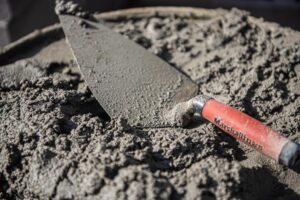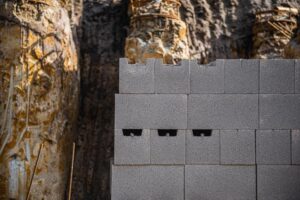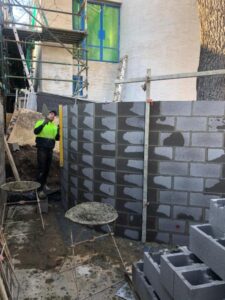The essential tools and equipment for bricklaying and blocklaying are trowels, grinders, block saws, brick saws, and brick & mortar saws. These tools ensure precision cutting and shaping of bricks and blocks, which is essential for quality masonry work. A commercial blocklayer relies on these to maintain efficiency and achieve a professional finish.
This blog will expand on the power tools used by blocklayers and bricklayers and their safety equipment.
What Power Tools Do Blocklayers Use?
Blocklayers primarily use power tools like 9-inch grinders, block saws, and hammer drills to ensure precision and efficiency in their masonry work. The 9-inch grinder is commonly used for cutting reinforcing steel, providing the strength and stability required for construction. Block saws, which are larger than brick saws to accommodate bigger blocks, are essential for making clean, accurate cuts. Additionally, heavy-duty hammer drills are used to drill into slabs and install reinforcing bars. When used skillfully, these tools enable blocklayers to consistently deliver sturdy, beautifully finished projects.
Learn about the proper steps to residential blocklaying by reading our blog today.
What Power Tools Do Bricklayers Use?
Bricklayers primarily use power tools like grinders, brick saws, and brick & mortar saws to achieve precise cuts and shapes, ensuring each brick and block fits perfectly. Grinders are particularly useful for cutting steel and making intricate cuts on bricks. Brick saws provide clean, accurate cuts, which are crucial for building solid and visually appealing structures. Brick & mortar saws, such as the Arbortech Allsaw, are a safe option for removing mortar from a brick wall, allowing bricks to be removed with minimal dust and disruption.

What Safety Equipment Do Bricklayers Use?
The following are the safety equipment blocklayers use:
Blocklayers in Australia use the following safety equipment:
- Hard hats: Protects the head from falling objects and potential impact injuries. They are a mandatory safety measure on all construction sites.
- Safety goggles: Shields the eyes from dust, debris, and flying particles. They also help prevent eye irritation from cement and mortar.
- High-visibility vests: Ensures workers are easily seen, reducing the risk of accidents. These vests are especially crucial in low-light conditions or busy areas.
- Steel-toe boots: Provides foot protection from heavy objects and sharp debris. They also offer support and stability on uneven surfaces.
- Hearing protection (earplugs or earmuffs): Guards against hearing damage from loud machinery and tools. Prolonged exposure to noise can lead to permanent hearing loss, making these essential.
- Dust masks or respirators: Prevents inhalation of harmful dust and airborne particles. They are particularly important when cutting or grinding materials.
- Gloves: Protects hands from cuts, abrasions, and chemical exposure. They also improve grip and dexterity while handling tools and materials.
- Safety harnesses: Secures workers and prevents falls when working at heights. They are critical for complying with safety regulations and ensuring worker safety.
Looking to find out how to mix mortar like a professional bricklayer? Check out our other blog articles.




